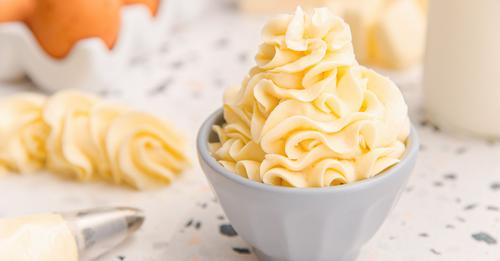German Buttercream frosting uses butter and a rich, yet simple vanilla custard to create a silky, melt-in-your mouth frosting perfect for sheet cakes and cupcakes.
If you’re not a fan of overly sweet buttercream, this vanilla-flavored frosting just may become your new bestie. German buttercream is a custard and butter-based frosting that’s mildly sweetened
For me, it’s thick, fluffy consistency makes it my preferred icing for sheet cakes and cupcakes, as it lends itself well to piping, decorating and filling pastries.FEATURED VIDEOhttps://imasdk.googleapis.com/js/core/bridge3.503.0_en.html#goog_11293412610 seconds of 1 minute, 38 secondsVolume 0%01:37 Zucchini Muffins
What is German Buttercream?
During my six years of living in Germany I never heard the term “German Buttercream,” being used. However, the custard base for this recipe is similar to the Bavarian custard used in many desserts from that region.https://e6df65c6e0781504564d58797b6a86b3.safeframe.googlesyndication.com/safeframe/1-0-38/html/container.html
Shirle O. Corriher, James Beard Award winning writer and author of Bake Wise, calls it Crème Anglaise Buttercream. Regardless of who calls it what, German Buttercream is a combination pastry cream plus butter.
Ultimately, what you need to know is this frosting is a two-part process of making the pastry cream, then whipping it with butter. It’s rich because of the use of egg yolks, can be flavored by steeping different ingredients in the milk when you make the pastry cream — think vanilla beans, coffee beans, or citrus rinds. Use it to frost the outside of a cake or fill the inside of an éclair.
:max_bytes(150000):strip_icc():format(webp)/Simply-Recipes-German-Buttercream-Frosting-LEAD-2-5623b694f4064fc09549970cb027f616.jpg)
How to Make German Buttercream
German buttercream does make you work for the pleasure of its company. While the individual components, the vanilla custard and butter, are simple enough to prepare, combining them into a perfect union can be fickle.
I prefer to make a thicker vanilla custard by using a splash of vanilla extract to flavor the milk and keep the flavoring simple rather than infusing it.
To prepare the custard: Heating sweetened, cornstarch-laced milk to a simmer before gradually whisking it into eggs to temper them. This mixture is briefly heated to further thicken it before flavoring it to your liking.
After a cooling down period, the custard is slowly added to fluffy, whipped butter to create a silky, almost ethereal frosting perfect for slathering on your cakes and cupcakes.
How to Flavor German Buttercream
There are two “optimal times” to flavor German buttercream: before cooking the custard or after the custard has thickened.
You can infuse the milk before combining it with sugar and cornstarch. Once the milk begins to steam (reaches a temp between 120°F-140°F), turn off the heat and allow the infusions to steep in the milk for 20 minutes. Remove the peel/nuts/beans/spices and use the milk as instructed.
Here are some ideas:
- Split vanilla beans
- Citrus peels
- Nuts like ground hazelnuts or almonds
- Coffee beans
- Cinnamon sticks (or similar spices)
On the flip side, you can add in any extract you’d like. Once the custard is completely mixed and thickened you can simply swap out the vanilla extract in this recipe for your preferred extract or liqueurs.
:max_bytes(150000):strip_icc():format(webp)/Simply-Recipes-German-Buttercream-Frosting-LEAD-7-d042f40ba5c34d55a91bc6e03252cba6.jpg)
How to Color German Buttercream
If you want to color your German buttercream, it is best to do it once the custard is fully incorporated into the butter.
- Use a gel-based food color.
- Gel coloring helps maintain the balance of the buttercream and often provides better pigmentation. Start by stirring in 1/8 teaspoon of color and add more until you reach your desired shade.
- Liquid food coloring will disrupt the balance of fat to water and may curdle the buttercream depending on how much you add. I would avoid it.
How to Store and Rewhip German Buttercream
German buttercream is both fridge and freezer-friendly, just transfer your frosting to a storage container and it will keep for 4 days in the fridge or 2 months in the freezer.
To rewhip from the fridge: The buttercream will need to warm up at room temperature for 10 minutes before mixing on low speed until it’s smooth again.
To rewhip from frozen: Thaw the frozen buttercream in the fridge before mixing to fluff it up again. It is important to remember that “reviving” German buttercream doesn’t work the same as other buttercreams:
- Soften the buttercream again by gently heating the frosting over a double boiler (a bowl set over a pot of gently simmering water). If you have a butane torch, you can also zap the bottom of your mixer bowl with the flame to warm it slightly.
- When the buttercream starts to become glossy, whip it on medium-high speed (#5 on a KitchenAid) until smooth.
- If you went a little trigger happy with heating the buttercream, just pop it back into the fridge to cool it down before whipping until fluffy.
:max_bytes(150000):strip_icc():format(webp)/Simply-Recipes-German-Buttercream-Frosting-LEAD-4-9de9b3e2d169434f9fbb2f1f071948aa.jpg)
Tips for Troubleshooting German Buttercream
I’ll be the first to admit that German buttercream was the one that gave me the hardest time in culinary school. It requires you to understand its nuances, whereas other frostings just go from A to B. This German Buttercream requires multiple steps each with its own special requirements. Here are some things to watch for, tips to keep you going, and useful bits of information.
- Before adding the butter make sure you whisk the custard until it’s smooth.
- Once the custard cools you can strain it through a fine mesh sieve to remove any rogue lumps.
- The butter and the custard should be the same temperature when combining the two. If one is colder than the other the frosting could separate and weep.
Slow and steady is the name of the game when it comes to adding the custard to the whipped butter—think a tablespoon at a time.
- If the buttercream is too stiff, you can warm it slightly over a double-boiler and whip it until it comes together.
- If the buttercream is too loose, chill it for 30 minutes before whipping again.
- If all else fails, try whipping in an additional 2 to 3 tablespoons of softened butter.
:max_bytes(150000):strip_icc():format(webp)/Simply-Recipes-German-Buttercream-Frosting-LEAD-5-3cdff62c55a1437bb43076d05ccd588b.jpg)
German Buttercream Snapshot:
- Taste: mildly sweet, rich, and creamy
- Texture: silky, thick, and fluffy
- Piping: great for piping rosettes and borders. Not so great for roses and flowers that require a firm consistency.
- Works best on: cupcakes, sheet cakes, as a pastry filling
- Make-ahead: You can frost a cake a day ahead of time with this buttercream.
German Buttercream Drawbacks:
- This buttercream can be fickle if you’re not mindful of the temperatures while mixing it
- Not suitable for hot, outdoor environments
- Needs to be stored in the fridge
German Buttercream Frosting
PREP TIME25 minsCOOK TIME10 minsCOOLING TIME4 hrsTOTAL TIME4 hrs 35 minsSERVINGS40 servingsYIELD5 cups of frosting
This recipe will generously frost and fill a 2-layer, 9-inch cake with enough frosting leftover to pipe a simple border. It can also frost a 9×13-inch, 1-layer sheet cake with enough left over to frost a border.
Ingredients
- 3/4 cup (165g) granulated sugar
- 1/4 cup (30g) cornstarch
- 1/2 teaspoon kosher salt
- 1 1/2 cups whole milk
- 6 large (105g) egg yolks
- 1 tablespoon vanilla extract
- 2 1/2 cups (565g) unsalted butter, at room temperature
Method
- Make milk mixture:In a medium saucepan (preferably one with sloped sides), whisk together the sugar, cornstarch, and salt until combined.Add about 1/4 cup of milk to the sugar mixture, whisking to form a thick paste. This will keep the mixture from forming clumps when you add the remaining milk. Add the rest of the milk to the pot, whisking to incorporate it.
- Bring milk mixture to a simmer:Turn the stove on to medium heat and bring the milk mixture to a gentle simmer, which will take 5-6 minutes. Tiny bubbles will rise to the surface and calmly break. The surface of the liquid should barely move. Remove the pot from the heat.
:max_bytes(150000):strip_icc():format(webp)/Simply-Recipes-German-Buttercream-Frosting-METHOD-1-3da38590da03405c80354447bb442dd3.jpg)
- Beat the eggs:Use a fork to lightly beat the egg yolks until they are runny.
- Temper the egg yolks:Slowly pour a cup of the warm milk mixture in a thin, steady stream into the bowl with the eggs while whisking constantly. Once combined slowly pour the milk-egg mixture in a slow, steady stream into the saucepan of hot milk while whisking constantly. You now have the base for custard.
:max_bytes(150000):strip_icc():format(webp)/Simply-Recipes-German-Buttercream-Frosting-METHOD-2-68740a541c644e39b3120ebc5b8cfe7b.jpg)
:max_bytes(150000):strip_icc():format(webp)/Simply-Recipes-German-Buttercream-Frosting-METHOD-5-02bf36ca916e494bbb56ec26fc5a508f.jpg)
- Finish the custard:Return the pot to the stove and heat the custard mixture to a gentle simmer over medium-low heat, constantly stirring with the whisk. The mixture will thicken considerably in 2-3 minutes.In order to tell if the custard is ready: dip a spoon in the custard and it should be thick enough for its edges to hold a line drawn with your finger on the back of the spoon.Stir in the vanilla extract until the mixture is smooth and combined.
- Cover and chill the custard:Cover and chill the custard until cool (or until it reaches room temperature). You can press a piece of plastic wrap directly onto the surface of the custard and chill it for up to 2 days in the refrigerator. If you chill it, it needs to be brought to room temperature before proceeding.
- Whip the butter in a stand mixer:In the bowl of your stand mixer fitted with the whisk attachment add the butter. Turn the mixer to medium and gradually bring the mixer speed up to high speed to whip the butter until very light, fluffy, and almost white in appearance, 5-6 minutes.Stop the mixer and scrape down the bowl once or twice during this whipping process.
:max_bytes(150000):strip_icc():format(webp)/Simply-Recipes-German-Buttercream-Frosting-METHOD-3-8a87fcc96b16470d9876ef4b61447d54.jpg)
- Add custard to the butter:While the butter is whipping, give the chilled custard a thorough stir to make it smooth. Decrease the mixer’s speed to medium-low and add the custard to the butter in the bowl 1 tablespoonful at a time. Allow the custard to be fully incorporated before adding the next tablespoonful.Scrape down the bowl often while adding the custard to make sure it’s properly incorporated.
:max_bytes(150000):strip_icc():format(webp)/Simply-Recipes-German-Buttercream-Frosting-METHOD-6-fe5115274aa74e518e2dd365370f2479.jpg)
- Whip buttercream on medium-high:Once the custard has been added, increase the mixer’s speed to medium-high and whip until the mixture is light and fluffy, 2-3 minutes.
:max_bytes(150000):strip_icc():format(webp)/Simply-Recipes-German-Buttercream-Frosting-METHOD-7-6b958b5c979a4dd4aab8471ceedaf016.jpg)
- Store buttercream:Once mixed, use the buttercream as desired. Store in a food storage container for up to 4 days or freeze for up to 2 months.
- Rewhip buttercream:To rewhip from the fridge: The buttercream will need to warm up at room temperature for 10 minutes before mixing on low speed until it’s smooth again.To rewhip from frozen: Soften the buttercream again by gently heating the frosting over a double boiler (a bowl set over a pot of gently simmering water).If you have a butane torch, you can also zap the bottom of your mixer bowl with the flame to warm it slightly. When the buttercream starts to become glossy, whip it on medium-high speed (#5 on a KitchenAid) until smooth.If you went a little trigger happy with heating the buttercream, just pop it back into the fridge to cool it down before whipping until fluffy.
:max_bytes(150000):strip_icc():format(webp)/Simply-Recipes-German-Buttercream-Frosting-METHOD-8-e41cd80a146e4d4ab58661f18762c3ba.jpg)
| NUTRITION FACTS(PER SERVING) | |
|---|---|
| 135 | CALORIES |
| 12g | FAT |
| 5g | CARBS |
| 1g | PROTEIN |
Show Full Nutrition Label
Nutrition information is calculated using an ingredient database and should be considered an estimate. In cases where multiple ingredient alternatives are given, the first listed is calculated for nutrition. Garnishes and optional ingredients are not included.










